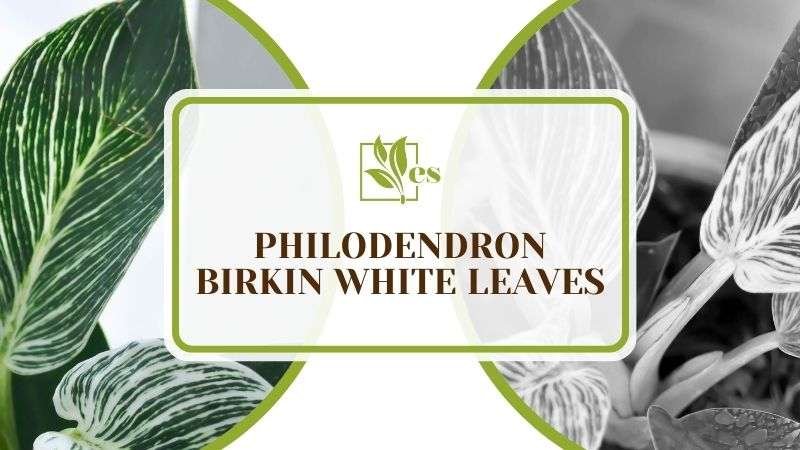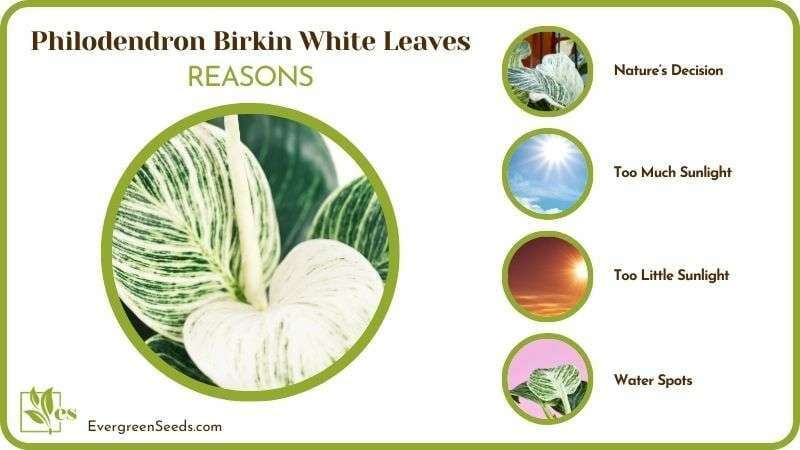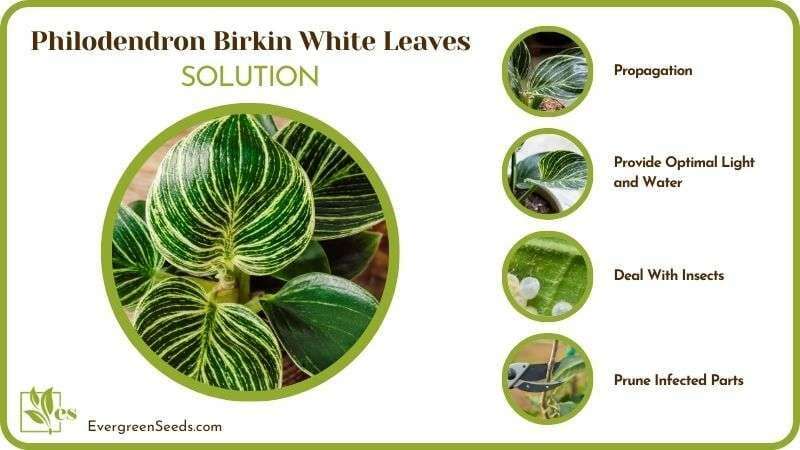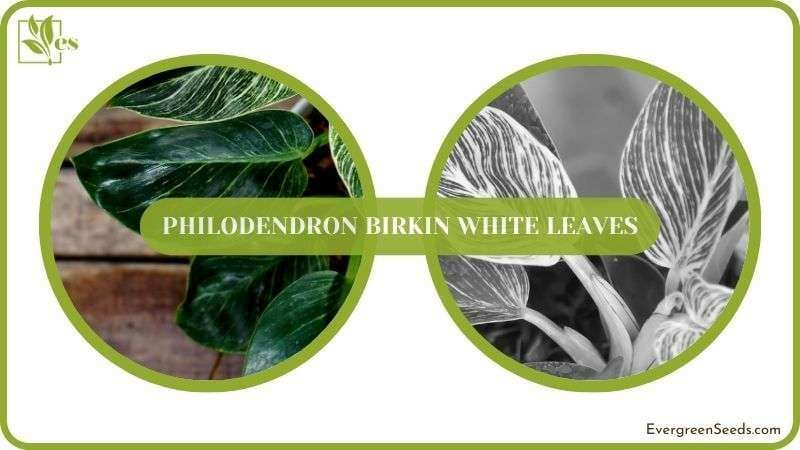Philodendron Birkin white leaves are caused by several factors, which are sunburn, too little light, water spots, fungus attack, and insect infestation.

No matter the reason, the good thing is that it is really easy to deal with this issue – take action such as propagating or providing optimal light conditions.
Read on to learn what causes leaves whitening and how to fix the problem.
JUMP TO TOPIC
What Causes White Leaves on Philodendron Birkin?
The causes of white leaves on philodendron birkin are genetics, incorrect lighting conditions, water spots, pest infestation, mineral deficiencies, and fungal diseases. In addition, when insect infestation occurs, the leaves can also become pale, and white to yellow spots can emerge.
– Nature’s Decision
Those who grow philodendron birkin plants for the first time have yet to learn much about how this house plant usually grows and behaves. So, when they see white leaves, they are concerned that the plant might face problems.
But the thing is, younger birkin leaves are naturally white. They are all white when new and develop a green color with time. So, if the plant has small whitish leaves, don’t worry. It’s all part of nature’s plan.
– Too Much Sunlight
If the leaves become a little older and stay white, they may be facing some stress. One of the common issues that philodendron birkin faces is sunburn due to excessive sunlight.
Sunburn or leaf scorching from too much sunlight occurs when cells start to die because of high UV rays. Furthermore, the moisture in the leaves will also dry up when high-intensity light falls on them, causing them to turn pale or white. Similarly, humidity levels also decrease during a hot day. You will notice leaves turning yellow and curling upward when this condition persists.

– Too Little Sunlight
Philodendron birkin required 12 hours of indirect light to stay healthy. If it doesn’t get it, you will see discoloration on the leaves. Photosynthesis (plants’ energy generation process) depends on light availability.
So, when plants receive insufficient light, they won’t have enough energy to keep their colors green. Since there are naturally white stripes on the leaves, the whiteness will start to spread. This will impact the philodendron birkin variegation, which is highly undesirable. Moreover, you will also see yellowing leaves in most cases of inadequate sunlight.
– Water Spots
When you mist plants, the drops can stay on them for a long time. After some time, white patches can emerge on such drop spots, known as water spots. It usually happens when you spray hard water with a lot of calcium and lime.
Moreover, the condition can get severe when there are winters or cloudy days as not enough light and heat is available in such weather to dry these water drops quickly. Furthermore, high humidity also promotes white patches on leaves.
– Fungal Disease
Philodendron Birkin plants are susceptible to some fungal diseases if you don’t follow proper growing practices. Let’s look at which top two fungal diseases cause the plant leaves to turn white.
Powdery Mildew is a common disease that causes white spots on leaves and stems. These white spots emerge on the top surface and rarely appear on the underside. After some time, you will also notice Philodendron Birkin white leaves turning brown. So, if you see young or new leaves having a powdery white appearance that turns brown, then it is powdery mildew.
Root rot is another fungal disease that also leads to leaf discoloration on the leaves. In this, roots are harmed, and you can also smell a foul smell near the root region. This disease can infect the stem, too (just like many other fungal diseases).
– Pest Infestation
When a birkin leaf turns white, then check for pest infestation. The insects suck the cell sap, causing them to turn pale, white, and even yellow. The common pests on philodendron birkins are spider mites, thrips, and scales.
When the infestation gets severe, you will also see leaves curling. When these insects suck the juice, chlorophyll gets depleted, which causes leaves to lose their vigor and shape. So, if you see white spots and curling, look for tiny insects around them and apply appropriate sprays.
– Mineral Deficiencies
If you don’t add nutrients regularly, mineral deficiency can cause leaf discoloration. It is because nutrients like nitrogen, magnesium, and sulfur form chlorophyll – a pigment that makes leaves green.
So, when there aren’t enough nutrients, chlorophyll does not form at optimal levels. When this happens, leaves won’t stay green and start to pale. In most cases, nutrient-deficient leaves usually appear white to yellow.
– Other Stresses
Some more common problems bug philodendron birkin and cause leaves to become white. These are exposure to chemicals, waterlogging, and unsuitable soil pH. Chemicals kill the plant cells, which leads to white to brown spots. In addition, when there are waterlogged conditions, roots will find it hard to breathe as the oxygen supply will get limited. As a result, moisture and nutrient absorption won’t normally occur, leading to whitish curling leaves.
Similarly, nutrient uptake is affected when there is an imbalance of pH, leading to a nutrient deficiency situation. You can fix philodendron birkin’s whitish leaves when you follow some specific plant care tips.
How to Fix Philodendron Birkin White Leaves?
To fix philodendron birkin’s white leaves, you should cut a stem and propagate a new plant to improve the lighting and aeration. In addition, pruning infected parts, applying insecticides, and making sure plants get proper light and water are some of the other fixes you must try.
– Propagation
As mentioned above, plants need to receive proper light. So, when you feel the lower ones are not getting enough light, complete philodendron birkin propagation.
- First, do the stem cutting. Use a sharp knife, scissors, or blade to cut the stem with a leaf. The cut should be made right below the node. If there are aerial roots, then it is even better.
- Add water to a glass and put the stem in it. Then, place the glass in such a spot that the leaf will receive around 10 – 12 hours of indirect light.
- Next, add a potting mix to a pot. When you see roots have developed in the glass, transplant them into this pot.
– Provide Optimal Light and Water
You have to respect plants’ growth habits. If they want more light, you must make arrangements to make it possible. Otherwise, they will show poor growth. One philodendron birkin rare behavior is that it requires lots of both light and water.
So, put the pots in those areas where 12 hours of indirect light is possible. This will help them keep their leaves in normal colors without any trouble. Similarly, birkins need water in large amounts to stay healthy. So, do not let the soil get dry, or the leaves will start to discolor.
But note that don’t “overdo” anything while ensuring they receive light and water. Letting them get more light than required can lead to sunburn. Similarly, adding lots of water can lead to fungal diseases.

– Deal With Insects
One crucial step of the philodendron birkin care guide is always ensuring the plant stays insect free. Therefore, if you see these unwanted creatures roaming around this plant, use organic repellents first. Neem oil, cayenne pepper, baking soda, and vinegar solutions are the best ones to keep insects away.
If you see more insects, it is better to choose chemical insecticides. It is because they are fast acting and will control the infestation quickly. Furthermore, it would help if you were careful during chemical insecticide application. It is better to wear a mask and goggles when you apply them, as the fumes might also harm your health.
– Prune Infected Parts
When you see white or yellow leaves, then chances are they are infected with a disease. So, it is better to immediately cut or prune off any affected part you see. Use sharp scissors or a blade to make a clean cut.
It is recommended not to bury a cut part in the soil as the disease spread can worsen. Similarly, putting in a home’s garbage can is not a good idea either. You should put the infected parts in a bag and throw them away. If the fungal attack is severe, get help from fungicides.
– Transplant to a Larger Pot
It would help if you also considered moving the plant to a bigger pot when seeing white and brown leaves. It is because Philodendron Birkin growing becomes easier when you do this. How? In bigger pots, there will be more soil, which means more nutrients. Similarly, watering gets better as there is more volume. This will make sure leaves remain green with elegant white stripes on them.
People, who like the beautiful white stripes on birkin, often ask “can philodendron birkin revert?” Well, if you don’t take care of plants and do not provide them with optimal conditions for growth, then yes, the white variegation can revert. When Birkin loses variegation, you will have a plant with ordinary leaves.
Therefore, consider repotting philodendron birkin. However, please don’t choose a huge pot, as it will cause trouble when you shift it. So, choose a reasonably big container or pot to enjoy full philodendron birkin benefits, including white variegation.
You can check out the following philodendron varieties: philodendron white princess, philodendron silver stripe, philodendron shangri la, philodendron ring of fire, philodendron jose buono, and philodendron spiritus sancti.













